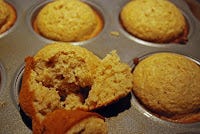'Pumpkin pie spice' versus volatile chemicals from artificial fragrance.
Real pumpkin pie spice is a combination of nutmeg, cloves, allspice, ginger and cinnamon or some variation of those. The group is very aromatic and medicinal. TRP channel activators = problem for IBS.
Do You Know What Is In Your “Pumpkin Pie Spice”?
Halloween is a time for disguise and surprise, but we don’t want our favorite foods to be in disguise. “Pumpkin Pie Spice” products these days are too often a trick instead of a treat.
Public Service Announcement via Environmental Working Group: Pumpkin spice surprise – the toxic chemicals lurking in ‘fragrance’ (ewg.org)- beware ‘air cleaners’ or fragrance devices with ‘Pumpkin Pie Spice’ or other popular scents. Many or most commercial products, whether food or air cleaners, may contain no actual spice in a product labeled “Pumpkin Pie Spice” scent or flavor.
The nutmeg and other zingy spices in the blend gives the real spice blend a bit of a peppy kick. It can beneficially affect the mood and energy level possibly. Artificial flavors are more likely to give you a headache and volatile chemicals tend to be inflammatory.
A similar blend is used in Spiced Apple Muffins, in one of my old recipes for a dry ingredient mix to make pancakes, muffins or other quick breads with, just a little quicker:
Spiced Apple Muffin variation:
1 cup Applesauce instead of water. Flavoring: 1 teaspoon Vanilla plus 2 teaspoons Ginger powder, 1/2 tsp Cardamom powder and 1/2 tsp Nutmeg powder.
**I like ginger, a traditional Pumpkin Pie Spice blend would have less ginger and would use cinnamon which gives me migraines, so I like cardamom instead.
The Applesauce muffin flavor could be the simple vanilla – up to 1 Tablespoon of Vanilla could be used if that is the only flavor. 1/2 teaspoon to 1 teaspoon of cinnamon would be typical with applesauce.
See Pancakes in a Jiffy - Quick Bread Mix. (transcendingsquare.com)
Cantalantern (*a closed post in my archives, circa Oct. 31, 2011)
Canta-lantern is a food safety reminder that is not intended to dishonor the dead but to remind us that anything can kill – even a cantaloupe. But don’t blame only cantaloupes – just take care of the foods you eat and learn how to be safe in the kitchen as well as the field and factory.
For current information about food safety issues around the world see- *my old links don’t work.
Cantaloupe are eaten raw and have a thin rind, which if wet, may allow pathogens to cross the rind and enter the flesh, especially when you are cutting the melon. Cantaloupe were in the news in 2011 as a food safety hazard and are back in the news this year as a salmonella risk. More cantaloupe recalled in Canada over Salmonella concerns, (foodsafetynews.com)
Short story - cantaloupe needs to stay dry as the rind is thin and food contamination was found to occur from a dirty rinse area, in 2011. Prior to finding out exactly where the contaminated cantaloupe were from, fields and fields of them were wasted, rototilled under after some deaths lead to a public panic and in my opinion the news media was not helping.
Romaine lettuce or other fresh veg which might get too wet like alfalfa sprouts can also be a food safety risk if a worker with dirty hands (salmonella or E. coli, fecal risk) was handling the wet food. Food contamination happens. We don’t have to panic about it, and knowing more about the risks might help still fear and reduce wasted food. Chicken can be a salmonella risk, so we cook it - 160’F is the recommended temperature to reach.
Heat to steaming is the food safety News-to-Use. If you have any question about whether your leftover food has been in the fridge too long, reheat to steaming - 140’F or above. A few food pathogens can leave an endotoxin in the food which heat wouldn’t remove, so leaving warm food out too long is still a food safety risk to avoid. Keep hot foods above 140’F and chill leftovers or a pot of soup or sauce rapidly by putting it in smaller, shallow containers, and/or stirring the hot food in the fridge occasionally and leave it uncovered initially to let all the steam escape rapidly.
Romaine lettuce isn’t typically heated but it could work as a soup green like spinach or kale.
Cantaloupe isn’t typically heated but I tried sauteeing slabs of it - heat to steaming and sprinkle with a little cardamom or Pumpkin Pie Spice - eat immediately. Oh, SO GOOD - like hot apple pie, except not quite. This could be a dessert for a group by broiling the slabs. The surface caramelizes a little.
We don’t know things until we learn them and sometimes that takes experimentation - trial and error. Sometimes we learn what doesn’t work - dirty, wet, conveyer belts for a thin-skinned fruit that likes to grow in Arizona - hot, sunny, and not damp — or artificial flavors disguised as a delicious and healing (if no TRP sensitivity) blend of cloves, nutmeg, allspice, cinnamon, and ginger.
If your Pumpkin Pie Spice product says artificial flavors instead of cloves, nutmeg, allspice, cinnamon, and ginger, or some variation of that - look for another product.
Food safety resources online:
The food industry does work very hard to process and package food in ways that keeps it safe and fresh for as long as possible.
Spanish Food Safety Agency Identifies Which Fruits, Vegetables are Most Risky to Sell in Bulk, By Food Safety Magazine Editorial Team, food-safety.com. Delicate fruits and fresh herbs, sprouts and greens tend to have the most risk from processing as they bruise easily and lose water or get too water logged.
Regarding which produce is least safe to be sold in bulk bins:
“AESAN proposes a non-exhaustive list of the most commonly consumed fruits, vegetables, tubers, or mushrooms that present a risk of spoilage or depletion when sold in bulk, based on the risk of mechanical damage, water loss, and microbial spoilage by pathogenic or spoilage microorganisms. The list of commodities and their assigned overall risk levels are as follows:
Very high: Red fruits (blueberries, raspberries, strawberries, blackberries, and currants) and sprouts
High: Edible flowers, aromatic herbs (peppermint, mint, coriander, chives, parsley, basil, dill, cherries, and fresh oregano), some pome fruits (grapes, lychees, and physalis), some leafy vegetables (lettuce, endive, buds, escarole, arugula, lamb's lettuce, chicory, kale, pak choi, chard, and spinach), mushrooms, stone fruits (cherries and apricots), infructescences (figs and fresh brews), and inflorescences (brussels sprouts, broccoli, and cauliflower)
Medium: Stem and root vegetables (celery, radishes, carrots, scallions, tender garlic, and asparagus), fruit vegetables (cherry tomatoes and mini varieties, and chili peppers), some pome fruits (loquats and persimmons), and some leafy vegetables (cabbage).
ASEAN concluded that no tubers present a significant risk when sold in bulk.” (food-safety.com)
Buffet food and vegetables were reported to be the leading food safety risks in Sweden by “Livsmedelsverket (known as the Swedish Food Agency in English).” A drop in food safety episodes occurred during CoV Lockdown and it has now returned to normal rates suggesting that eating at restaurants has returned to normal rates. Eating out is a risk too - steamer tables at buffets have to be kept up to the safe 140’F and hopefully the plastic spit-shield will prevent any contagious droplets from entering a cold dish.
Foodborne Illnesses in Sweden Return to Pre-Pandemic Levels, Mostly Caused by Vegetables, Buffets, By Food Safety Magazine Editorial Team (food-safety.com)
If you have any question about the safety of a fresh or leftover food, but it likely seems safe, then just be sure to heat it to steaming.
Food Safety and Inspection Service, USDA, How Temperature Affects Food (fsis.usda.gov) *Sign up for email updates about food safety news.
USDA Food Safety Booklet: Food Safety A Need-To-Know Guide for Those at Risk, (fsis.usda.gov) (36 page pdf) Who is most at risk? The elderly and very young, under 5 y/o, pregnant women, and cancer, diabetes or autoimmune patients, or immune compromised transplant recipients or HIV/AIDS patients - which means CoV survivors may also have greater risk due to reduced innate immunity.
Disclaimer: This information is being provided for educational purposes within the guidelines of Fair Use and is not intended to provide individual health care guidance.








Excellent article! Thanks for sharing all the wealth of information. I read and I am re-reading your article again... very informative and interesting. I look forward to reading your next article! Awesome 👏🏻 👏🏻👏🏻 Many thanks Jennifer.
Anything that TRP channel activators can't do to IBS, the EPA and DHA in omega three oils can finish.